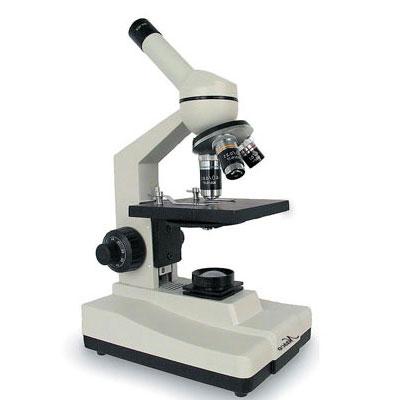Light microscope: Difference between revisions
Jump to navigation
Jump to search
Created page with "The light microscope uses light energy to see small objects on a slide through an eyepiece. The direction of light upon to the slide magnifies the size of the objects to the..." |
No edit summary |
||
| (10 intermediate revisions by 4 users not shown) | |||
| Line 1: | Line 1: | ||
[[Image:Light micro.jpg|right|A light microscope]] | |||
The light microscope uses light energy to see small objects on a slide through an eyepiece. The direction of light upon to the slide, focused by lenses, magnifies the size of the objects to the viewer<ref>http://www.ruf.rice.edu/~bioslabs/methods/microscopy/microscopy.html</ref>. | |||
=== Advantages === | |||
*Inexpensive to buy and operate | |||
*Relatively small | |||
*Both living and dead specimens can be viewed | |||
*Little expertise is required in order to set up and use the microscope | |||
*The original colour of the specimen can be viewed | |||
=== Disadvantages === | |||
*Maximum magnification of 1500x | |||
*Specimen may be disfigured during preparation to be viewed under the microscope | |||
*The resolving power is 1 nm for biological specimens | |||
*Only has a resolution of 0.2 μm - which is relatively poor in comparison to other microscopes<ref>Alberts B, Johnson A, Lewis J, Morgan D, Raff M, Roberts K, Walter P. Molecular Biology of the Cell. Sixth Edition, Garland Science, Taylor and Francis group, LLC and Informa business. 2014. Page 530</ref>. | |||
=== References === | |||
<references /><br> | |||
Latest revision as of 09:31, 10 December 2018

The light microscope uses light energy to see small objects on a slide through an eyepiece. The direction of light upon to the slide, focused by lenses, magnifies the size of the objects to the viewer[1].
Advantages
- Inexpensive to buy and operate
- Relatively small
- Both living and dead specimens can be viewed
- Little expertise is required in order to set up and use the microscope
- The original colour of the specimen can be viewed
Disadvantages
- Maximum magnification of 1500x
- Specimen may be disfigured during preparation to be viewed under the microscope
- The resolving power is 1 nm for biological specimens
- Only has a resolution of 0.2 μm - which is relatively poor in comparison to other microscopes[2].
References
- ↑ http://www.ruf.rice.edu/~bioslabs/methods/microscopy/microscopy.html
- ↑ Alberts B, Johnson A, Lewis J, Morgan D, Raff M, Roberts K, Walter P. Molecular Biology of the Cell. Sixth Edition, Garland Science, Taylor and Francis group, LLC and Informa business. 2014. Page 530